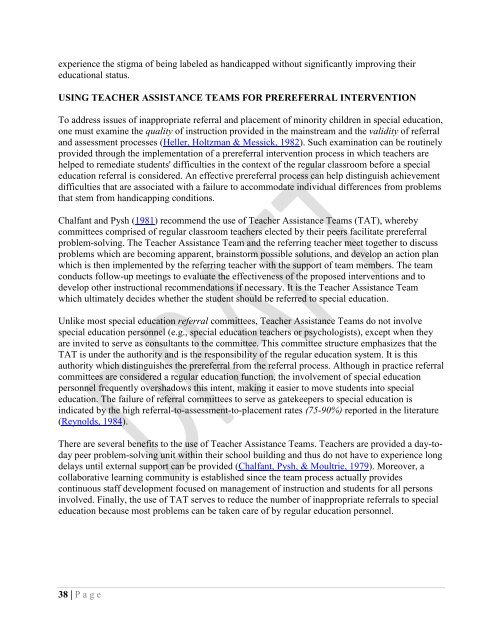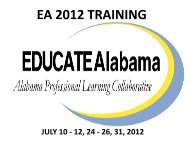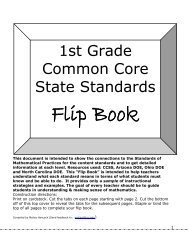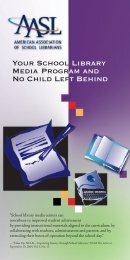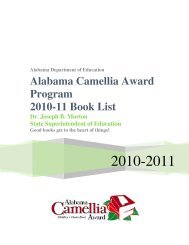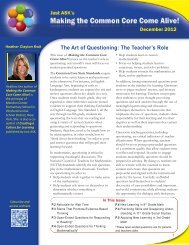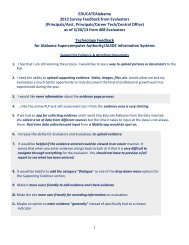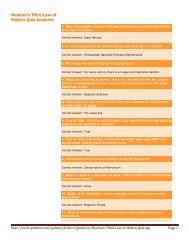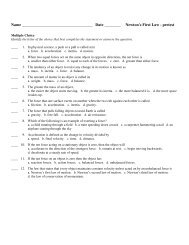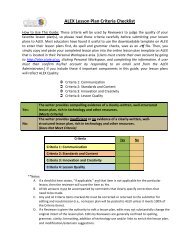(EL) Policy and Procedures Manual 9-6-11 Appendix Revised ... - Alex
(EL) Policy and Procedures Manual 9-6-11 Appendix Revised ... - Alex
(EL) Policy and Procedures Manual 9-6-11 Appendix Revised ... - Alex
Create successful ePaper yourself
Turn your PDF publications into a flip-book with our unique Google optimized e-Paper software.
experience the stigma of being labeled as h<strong>and</strong>icapped without significantly improving their<br />
educational status.<br />
USING TEACHER ASSISTANCE TEAMS FOR PREREFERRAL INTERVENTION<br />
To address issues of inappropriate referral <strong>and</strong> placement of minority children in special education,<br />
one must examine the quality of instruction provided in the mainstream <strong>and</strong> the validity of referral<br />
<strong>and</strong> assessment processes (Heller, Holtzman & Messick, 1982). Such examination can be routinely<br />
provided through the implementation of a prereferral intervention process in which teachers are<br />
helped to remediate students' difficulties in the context of the regular classroom before a special<br />
education referral is considered. An effective prereferral process can help distinguish achievement<br />
difficulties that are associated with a failure to accommodate individual differences from problems<br />
that stem from h<strong>and</strong>icapping conditions.<br />
Chalfant <strong>and</strong> Pysh (1981) recommend the use of Teacher Assistance Teams (TAT), whereby<br />
committees comprised of regular classroom teachers elected by their peers facilitate prereferral<br />
problem-solving. The Teacher Assistance Team <strong>and</strong> the referring teacher meet together to discuss<br />
problems which are becoming apparent, brainstorm possible solutions, <strong>and</strong> develop an action plan<br />
which is then implemented by the referring teacher with the support of team members. The team<br />
conducts follow-up meetings to evaluate the effectiveness of the proposed interventions <strong>and</strong> to<br />
develop other instructional recommendations if necessary. It is the Teacher Assistance Team<br />
which ultimately decides whether the student should be referred to special education.<br />
Unlike most special education referral committees, Teacher Assistance Teams do not involve<br />
special education personnel (e.g., special education teachers or psychologists), except when they<br />
are invited to serve as consultants to the committee. This committee structure emphasizes that the<br />
TAT is under the authority <strong>and</strong> is the responsibility of the regular education system. It is this<br />
authority which distinguishes the prereferral from the referral process. Although in practice referral<br />
committees are considered a regular education function, the involvement of special education<br />
personnel frequently overshadows this intent, making it easier to move students into special<br />
education. The failure of referral committees to serve as gatekeepers to special education is<br />
indicated by the high referral-to-assessment-to-placement rates (75-90%) reported in the literature<br />
(Reynolds, 1984).<br />
There are several benefits to the use of Teacher Assistance Teams. Teachers are provided a day-today<br />
peer problem-solving unit within their school building <strong>and</strong> thus do not have to experience long<br />
delays until external support can be provided (Chalfant, Pysh, & Moultrie, 1979). Moreover, a<br />
collaborative learning community is established since the team process actually provides<br />
continuous staff development focused on management of instruction <strong>and</strong> students for all persons<br />
involved. Finally, the use of TAT serves to reduce the number of inappropriate referrals to special<br />
education because most problems can be taken care of by regular education personnel.<br />
38 | P a g e


